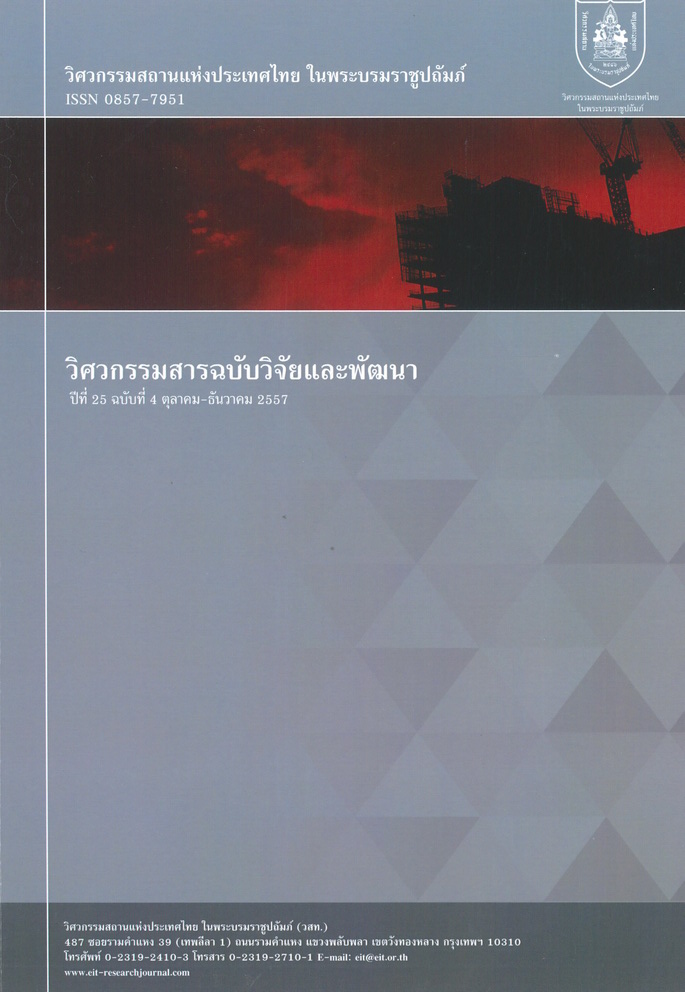OPTIMIZING TRAIN SPEED PROFILE FOR A MASS TRANSIT SYSTEM USING DIFFERENTIAL EVOLUTION
Main Article Content
Abstract
การทำงานของรถไฟฟ้าที่นำมาใช้มีทั้ง 4 โหมดตามลำดับ คือ โหมดการเร่ง โหมดความเร็วคงที่ โหมดการแล่น และโหมดการเบรก ปัญหาที่นำเสนอเป็นการหาค่าเหมาะที่สุดของลักษณะสมบัติความเร็วของรถไฟฟ้าโดยการควบคุมผ่านตัวแปร 3 ตัว คือ อัตราเร่งในโหมดการเร่ง อัตราหน่วงในโหมดการเบรก และตำแหน่งเริ่มต้นโหมดการแล่น เพื่อให้การเคลื่อนที่ของรถไฟฟ้าใช้พลังงานไฟฟ้าโดยรวมน้อยที่สุด การแก้ปัญหาใช้วิธีดิฟเฟอเรนเชียลอีโวลูชัน (Differential Evolution: DE) เปรียบเทียบผลเฉลยและประสิทธิภาพในการค้นหาคำตอบกับวิธีเชิงปัญญาประดิษฐ์ 2 วิธี คือ วิธีจีนเนติกอัลกอริทึม (Genetic Algorithm: GA) และวิธีหาค่าเหมาะที่สุดของฝูงอนุภาค (Particle Swarm Optimization: PSO) ระบบทดสอบที่นำมาใช้เป็นระบบรถไฟฟ้าขนส่งมวลชนที่มีสถานีผู้โดยสาร 2 สถานี ระยะทางระหว่างสถานีมีค่าเท่ากับ 2 กิโลเมตร กำหนดความเร็วในการเคลื่อนที่ไว้ที่ 80 และ 60 กิโลเมตรต่อชั่วโมง จากการจำลองผลพบว่า การควบคุมการทำงานของรถไฟฟ้าอย่างเหมาะสมด้วยวิธีดิฟเฟอเรนเชียลอีโวลูชัน สามารถช่วยให้ประหยัดพลังงานไฟฟ้าโดยรวมที่ใช้ในการเคลื่อนที่ของรถไฟฟ้าได้เป็นอย่างดี และมีประสิทธิภาพกว่าวิธีอื่น ภายใต้เงื่อนไขเดียวกัน
This paper presents a movement planning of a mass transit section between two-passenger stopping stations with the goal to minimize total energy consumption during the journey. Train movement in this work is based on a sequence of four mode operations: i) accelerating mode, ii) constant speed or cruising mode, iii) coasting mode and iv) braking mode. The presented problem is one of optimization problems in which train speed profile is optimized by controlling three parameters: i) acceleration rate ii) deceleration rate and iii) location of coasting point. To achieve this goal the overall energy consumption of the proposed journey is minimized. This paper described the use of Differential Evolution as a potential tool to solve the problem and compared to some well-known and efficient intelligent search techniques (Genetics Algorithm: GA and Particle Swarm Optimization: PSO). The test system used in this work is a simple mass transit section between two-passenger stopping stations with the service distance of 2 km and the maximum speed limit of 60 km/h and 80 km/h. The results showed that solving such a problem by using DE can considerably reduce the overall energy consumption and efficient than other methods under the same conditions.
Article Details
The published articles are copyright of the Engineering Journal of Research and Development, The Engineering Institute of Thailand Under H.M. The King's Patronage (EIT).


